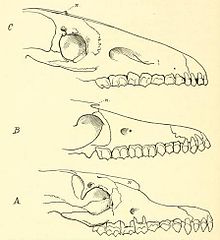| Scalabrinitherium Temporal range: Late Miocene (Huayquerian) ~9.0–7.246 Ma PreꞒ Ꞓ O S D C P T J K Pg N ↓ | |
|---|---|

| |
| Skulls of Macraucheniidae. A: Theosodon. B: Scalabrinitherium. C: Macrauchenia | |
| Scientific classification | |
| Domain: | Eukaryota |
| Kingdom: | Animalia |
| Phylum: | Chordata |
| Class: | Mammalia |
| Order: | †Litopterna |
| Family: | †Macraucheniidae |
| Subfamily: | †Macraucheniinae |
| Genus: | †Scalabrinitherium Ameghino 1883 |
| Type species | |
| †Scalabrinitherium bravardi | |
| Species | |
| |
Scalabrinitherium is an extinct genus of mammals of the family Macraucheniidae. Fossils of this animal were found among the fossils of prehistoric xenarthrans in the Ituzaingó Formation of Argentina.
Description
This animal was rather similar to a llama with a slightly heavy build; the skull was long and low, the front teeth were slightly spatulate, and the nasal aperture set far back. It is possible that there was a strong prehensile lip or a short proboscis. The height of this animal must have exceeded two meters; the limbs were slender but relatively heavy, three-toed.
Classification
The first paleontologist to describe the fossils of this animal was Bravard, who in 1858 attributed the fossils to a presumed South American species of the perissodactyl Palaeotherium, P. paranense. It was the Argentinean paleontologist Florentino Ameghino, in 1883, who described the genus Scalabrinitherium for this species, also describing the new species S. bravardi in the fauna of Entre Rios which dates to the Late Miocene. Later, in 1885, the same author described an additional species, S. rothii.
Scalabrinitherium was a rather derived representative of the Macraucheniidae, a group of litopterns with a camel-like appearance. Probably derived from lower Miocene forms such as Cramauchenia and Theosodon, this animal probably gave rise to the large macraucheniids of the Pliocene and Pleistocene, such as Macrauchenia and Xenorhinotherium.
Cladogram based in the phylogenetic analysis published by Schmidt et al., 2014, showing the position of Scalabrinitherium:
| |||||||||||||||||||||||||||||||||||||||||||||||||||||||||||||||||||||||||||||||||||||||||||||||||
Paleoenvironment
Fossils of Scalabrinitherium have been recovered from the Ituzaingó Formation of Entre Rios, Argentina, which preserves vast tidal flats similar to those in the modern day Amazon and a warm climate. Large, herbivorous notoungulate mammals in the Ituzaingó Formation were widespread, including the toxodontids Xotodon and Adinotherium, and fellow litopterns such as Brachytherium, Cullinia, Diadiaphorus, Neobrachytherium, Oxyodontherium, Paranauchenia, Promacrauchenia, and Proterotherium. Large, armored glyptodonts like Palaehoplophorus, Eleutherocercus, and Plohophorus lived in the area as well as other cingulates like the pampatheres Kraglievichia and Scirrotherium, and the dasypodid Dasypus neogaeus. Carnivores included the phorusrhacids Devincenzia and Andalgalornis and sparassodonts, with giant crocodilians like Gryposuchus and Mourasuchus in the freshwater. Bamboos, coconut palms, and other palms were also present.
References
- Scalabrinitherium at Fossilworks.org
- McGrath, Andrew J.; Anaya, Federico; Croft, Darin A. (2018-05-04). "Two new macraucheniids (Mammalia: Litopterna) from the late middle Miocene (Laventan South American Land Mammal Age) of Quebrada Honda, Bolivia". Journal of Vertebrate Paleontology. 38 (3): e1461632. Bibcode:2018JVPal..38E1632M. doi:10.1080/02724634.2018.1461632. ISSN 0272-4634. S2CID 89881990.
- ^ Schmidt, Gabriela I.; Ferrero, Brenda S. (September 2014). "Taxonomic Reinterpretation of Theosodon hystatus Cabrera and Kraglievich, 1931 (Litopterna, Macraucheniidae) and Phylogenetic Relationships of the Family". Journal of Vertebrate Paleontology. 34 (5): 1231–1238. Bibcode:2014JVPal..34.1231S. doi:10.1080/02724634.2014.837393. hdl:11336/18953.
- Cione, A. L., Dahdul, W. M., Lundberg, J. G., & Machado-Allison, A. (2009). Megapiranha paranensis, a new genus and species of Serrasalmidae (Characiformes, Teleostei) from the upper Miocene of Argentina. Journal of Vertebrate Paleontology, 29(2), 350-358.
- Schmidt, G. I. (2013). Los ungulados nativos (Litopterna y Notoungulata: Mammalia) del “Mesopotamiense”(Mioceno Tardío) de Entre Ríos, Argentina. Publicación Electrónica de la Asociación Paleontológica Argentina, 14(1).
- Schmidt, G. I. (2013). Litopterna y Notoungulata (Mammalia) de la Formación Ituzaingó (Mioceno tardío-Plioceno) de la Provincia de Entre Ríos: sistemática, bioestratigrafía y paleobiogeografía (Doctoral dissertation, Universidad Nacional de La Plata).
- Góis, Flávio; Scillato-Yané, Gustavo Juan; Carlini, Alfredo Armando; Guilherme, Edson (2013-06-01). "A new species of Scirrotherium Edmund & Theodor, 1997 (Xenarthra, Cingulata, Pampatheriidae) from the late Miocene of South America". Alcheringa: An Australasian Journal of Palaeontology. 37 (2): 177–188. Bibcode:2013Alch...37..177G. doi:10.1080/03115518.2013.733510. hdl:11336/18791. ISSN 0311-5518. S2CID 129039539.
- Alvarenga, Herculano M. F.; Höfling, Elizabeth (2003). "Systematic revision of the Phorusrhacidae (Aves: Ralliformes)". Papéis Avulsos de Zoologia. 43 (4): 55–91. doi:10.1590/S0031-10492003000400001. ISSN 0031-1049.
- Babot, J. M., & Ortiz, P. E. (2009). Primer registro de Borhyaenoidea (Mammalia, Metatheria, Sparassodonta) en la provincia de Tucumán (Formación India Muerta, Grupo Choromoro; Mioceno tardío). Acta Geológica Lilloana, 34-48.
- Riff, D., Romano, P. S. R., Oliveira, G. R., & Aguilera, O. A. (2010). Neogene crocodile and turtle fauna in northern South America. Amazonia. Landscapes and Species Evolution: A Look Into the Past, 259-280.
- Franco, M. J., & Brea, M. (2015). First extra-Patagonian record of Podocarpaceae fossil wood in the Upper Cenozoic (Ituzaingó Formation) of Argentina. New Zealand Journal of Botany, 53(2), 103-116.
Further reading
- F. Ameghino. 1885. Nuevos restos de mamíferos fósiles Oligocenos recogidos por el Profesor Pedro Scalabrini y pertenecientes al Museo Provincial de la ciudad del Paraná. Boletín de la Academia Nacional de Ciencias de Córdoba 8:1-205
- R. Lydekker. 1894. Contributions to a knowledge of the Fossil Vertebrates of Argentina. III - A study of extinct Argentine ungulates. Anales del Museo de La Plata. Paleontología Argentina 2(3):1-86
- Rusconi, С. 1932. Nuevos restos de Scalabrinitherium del Terciario de Paraná y apuntes relativos a su anatomía craneana. Rev. Med. Vet. Buenos Aires 15-19 nos. 2-0 1932 pp. 1-18
| Taxon identifiers | |
|---|---|
| Scalabrinitherium | |







